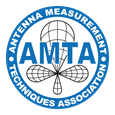Daniel Janse Van Rensburg, Allen Newell, Stuart Gregson, Pat Pelland, October 2017
Equivalent Isotropically Radiated Power (EIRP), Saturating Flux Density (SFD) and Group Delay (GD) are three system level parameters often measured during the characterization of spacecraft systems. EIRP is of interest for transmitters, SFD for receivers and GD for the entire up/down link. A test methodology for EIRP and SFD was first presented in [1] and [2] and a detailed procedure presented in [3]. To date GD has only been measured under far-field (or simulated far-field) conditions. In [4], a concept for measuring GD in a planar near-field (PNF) range is described, but no methodology is presented.
In this paper, we present a method for measuring GD in a planar near-field range. The technique is based on a set of three antenna pairs, measured sequentially, from which the insertion phase of the measurement system and the near-field probe [5] can be resolved. Once these parameters are known, insertion phase for the device under test (i.e. a Tx or Rx antenna) can be measured and GD calculated as the negative frequency derivative of the insertion phase. An added complexity in the case of a near-field measurement is the near-field probe is in close proximity to the device under test (not far-field condition) for which compensation is needed. We show through simulation and measurement, that the plane wave expansion allows us to compute a correction factor for the proximity of the probe to the device under test; thus allowing correction of the measured insertion phase.
The final step in measuring payload GD through both uplink and downlink channels is to set up a fixed Tx probe in close proximity to the Rx antenna and an equivalent Rx probe in close proximity to the Tx antenna and performing a through measurement as one would do on a far-field range. Correction factors for compensating for the proximity of both probes are then applied, based on independent a-priori Rx and Tx case measurements performed on the antennas.
Simulated and measured data will be presented to demonstrate the process and to illuminate some of the finer nuances of the correction being applied.
Index Terms— Group Delay, Planar Near-Field, Antenna Measurements, Three Antenna Method.
[1] A. C. Newell, R. D. Ward and E. J. McFarlane, “Gain and power parameter measurements using planar near-field techniques”, IEEE Trans. Antennas &Propagat, Vol 36, No. 6, June 1988
[2] A. C. Newell, “Planar near-field antenna measurements”, NIST EM Fields Division Report, Boulder, CO, March 1994.
[3] D. Janse van Rensburg and K. Haner, “EIRP & SFD Measurement methodology for
planar near-field antenna ranges”, Antenna Measurement Techniques Association Conference, October 2014.
[4] C. H. Schmidt, J. Migl, A. Geise and H. Steiner, “Comparison of payload applications in near field
and compact range facilities”, Antenna Measurement Techniques Association Conference, October 2015.
[5] A. Frandsen, D. W. Hess, S. Pivnenko and O. Breinbjerg, “An augmented three-antenna probe calibration technique for measuring probe insertion phase”, Antenna Measurement Techniques Association Conference, October 2003.
